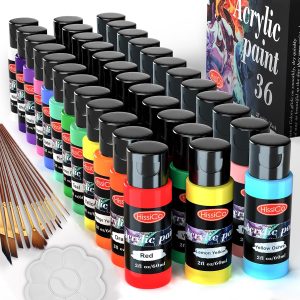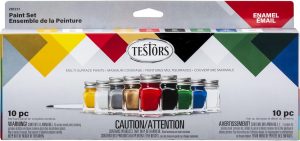When it comes to building and painting plastic models, whether it’s scale models of vehicles, airplanes, or figures, choosing the right paint can make a significant difference in the final appearance and durability of your project. The best paint for plastic models ensures that your work not only looks great but also stands the test of time. This guide will walk you through the essential aspects of selecting the right paint for plastic models, including the types of paints available, how to apply them, and tips for achieving the best results.
Why is Choosing the Right Paint for Plastic Models Important?
Plastic models, whether they are for display or for hobby purposes, require specific types of paint that adhere well to plastic surfaces and provide a smooth, durable finish. Unlike other surfaces like wood or metal, plastic models have their own set of challenges, such as maintaining proper adhesion without causing the paint to chip, peel, or crack over time. The right paint not only ensures a stunning appearance but also protects your model from wear and tear, dust, and other environmental factors.
Types of Paints for Plastic Models
When selecting the best paint for plastic models, there are a few different types of paints to consider. Each type has its unique characteristics, advantages, and ideal uses. Below are the most common types of paints used for plastic models:
1. Acrylic Paints

Acrylic paints are one of the most popular choices for plastic models due to their ease of use, quick drying time, and low toxicity. These water-based paints come in a wide variety of colors and finishes, and they can be thinned and mixed easily to achieve the desired consistency and tone.
Benefits of Acrylic Paints:
- Fast Drying: Acrylic paint dries relatively quickly, allowing you to layer multiple coats or move on to the next step in the painting process sooner.
- Low Odor and Non-Toxic: Since they are water-based, acrylics are safer to use in confined spaces, and they emit little to no odor compared to solvent-based paints.
- Easy to Clean: Brushes and tools used with acrylics are easy to clean with water.
- Flexible and Durable: Acrylics are known for their flexibility, which helps prevent cracking or chipping on the plastic surface.
Recommended Acrylic Paints for Plastic Models:
- Tamiya Acrylic Paints: Known for their fine quality, Tamiya acrylics offer a wide selection of colors and are highly regarded in the modeling community.
- Vallejo Model Color: This brand offers excellent pigment consistency and a smooth finish. Their paints are known for good coverage and minimal thinning.
- Testors Model Master Acrylics: Another popular brand, Testors offers a wide range of acrylic paints, including a variety of military, aircraft, and automotive colors.
2. Enamel Paints

Enamel paints are oil-based and are known for their durability and long-lasting finish. They are often used for model painting when a glossy or highly durable finish is required, especially for items that will be handled frequently.
Benefits of Enamel Paints:
- Durability: Enamel paints are more resistant to scratches and chips compared to acrylic paints, making them a good choice for models that will be handled often.
- Smooth Finish: Enamel paints provide a smooth, glossy finish and are ideal for creating an even, uniform look.
- Longer Drying Time: The slower drying time of enamel paints allows for more working time to blend colors, create gradients, and fix mistakes.
- Excellent Coverage: Enamel paints often require fewer coats to achieve complete coverage on the model.
Recommended Enamel Paints for Plastic Models:
- Testors Enamel Paints: A reliable and long-standing brand in the modeling world, Testors enamel paints offer a wide range of colors and are known for their smooth finish and excellent durability.
- Humbrol Enamel Paints: Humbrol offers high-quality enamel paints with exceptional coverage and a glossy finish. They are a favorite among modelers who focus on military or historical figures.
- Revell Enamel Paints: Known for their extensive range of colors, Revell enamel paints are a great option for detailed and durable finishes on plastic models.
3. Lacquer Paints

Lacquer paints are a type of solvent-based paint that provides a highly durable and glossy finish. They are less commonly used than acrylics or enamels but are favored by some modelers for their high-quality finish and resistance to wear.
Benefits of Lacquer Paints:
- Superior Gloss: Lacquer paints are known for their high-gloss finish, which can add depth and a professional sheen to your models.
- Durability: Lacquer paints are resistant to chips, scratches, and fading, making them ideal for models that need to endure handling or environmental factors.
- Quick Drying Time: Lacquers dry quickly, allowing you to finish your project more efficiently.
Recommended Lacquer Paints for Plastic Models:
- Mr. Color Lacquer Paints: Mr. Color offers a wide selection of colors and a smooth finish. Their paints are popular among modelers looking for a durable and glossy finish.
- Tamiya Lacquer Paints: Known for their smooth finish and vibrant colors, Tamiya lacquer paints are a go-to for modelers who prefer solvent-based options.
4. Spray Paints

Spray paints are available in both acrylic and enamel formulations and are ideal for covering large surfaces quickly and evenly. They are often used for priming models or applying base coats before detailed painting.
Benefits of Spray Paints:
- Even Coverage: Spray paints can quickly cover large areas without brush marks, making them ideal for base coats or large-scale plastic models.
- Smooth Finish: They provide a smooth, uniform finish that is difficult to achieve with hand painting.
- Efficient and Time-Saving: Spray paints are efficient, making them perfect for modelers who want to save time during the painting process.
Recommended Spray Paints for Plastic Models:
- Tamiya Spray Paints: These high-quality spray paints are widely regarded in the modeling community for their consistent and even coverage.
- Rust-Oleum Universal Spray Paint: Known for its versatility, Rust-Oleum spray paint works well for plastic models and is available in both matte and gloss finishes.
How to Paint Plastic Models: Step-by-Step Guide
Now that you know the different types of paints, let’s explore how to properly paint plastic models to achieve the best results.
Step 1: Prepare the Surface
Before painting, it’s crucial to prepare the plastic model surface. Clean the model thoroughly to remove any dust, oils, or mold release agents that may be present. You can use warm water and mild soap or a specialized plastic cleaner. Once cleaned, allow the model to dry completely before proceeding.
Step 2: Prime the Model
Priming is an essential step in the painting process, as it ensures that the paint adheres properly to the plastic surface. Choose a primer that is designed for plastic models. You can use either a spray primer or a brush-on primer, depending on your preference. Apply a thin, even coat and let it dry completely before moving on to painting.
Step 3: Apply the Base Coat
Once the primer is dry, apply the base coat of paint. For most models, a base coat of paint will serve as the foundation for all subsequent layers. You can use either a brush or spray paint for this step. If you’re using spray paint, make sure to apply light, even coats, allowing each layer to dry before applying the next.
Step 4: Add Details and Layers
After applying the base coat, it’s time to add details and additional layers. This can include painting small parts of the model or applying different colors to various sections. When using a brush, be sure to use fine-tipped brushes for small, intricate details. For spray painting, you may want to mask off areas you don’t want to paint.
Step 5: Finish with a Clear Coat
Once you’ve applied all of your paint layers and are satisfied with the results, it’s time to apply a clear coat to seal and protect the paint. Clear coats are available in matte, satin, and gloss finishes, depending on the look you want to achieve. Apply the clear coat in thin, even layers to avoid drips and ensure a smooth finish.
Step 6: Allow the Model to Dry and Cure
After applying the final clear coat, allow the model to dry completely. Depending on the type of paint and clear coat used, this could take several hours to a few days. Ensure the model is placed in a dust-free area to avoid contamination during the curing process.
Frequently Asked Questions
1. What type of paint is best for plastic models?
The best paint for plastic models depends on your needs and the type of finish you prefer. Acrylic paints are great for beginners due to their fast drying time and ease of use. Enamel paints offer superior durability, while lacquer paints provide a high-gloss, durable finish.
2. Can I use regular spray paint on plastic models?
Regular spray paint can work on plastic models, but it’s not always ideal. Spray paints designed specifically for plastic models provide better adhesion and a smoother finish. Look for paints labeled for plastic use to avoid issues with peeling or cracking.
3. Do I need to prime plastic models before painting?
Yes, priming plastic models is essential for ensuring that the paint adheres properly and lasts longer. Priming also helps create a smoother surface and enhances the overall finish of your model.
4. How can I prevent paint from chipping off my plastic model?
To prevent paint from chipping, ensure that you apply a good primer before painting, use high-quality paint designed for plastic, and finish with a clear protective coat. Handling the model carefully and allowing it to fully cure before touching it can also help prevent chips.
5. Can I mix different types of paints on a plastic model?
Mixing different types of paints (e.g., acrylic and enamel) on the same model is not recommended. These paints have different drying times, adhesion properties, and finishes, which can lead to poor results. Stick to one type of paint for the best outcome.
6. How long does it take for the paint to dry on a plastic model?
Drying times vary based on the type of paint used. Acrylic paints typically dry within 30 minutes to an hour, while enamel and lacquer paints may take several hours or even overnight to fully dry. Always check the manufacturer’s instructions for drying times.
7. Can I touch up mistakes after painting my plastic model?
Yes, if you make a mistake, you can touch it up after the paint has dried. For small mistakes, use a fine brush to carefully correct the error. If you’ve applied multiple layers, you may need to sand the area lightly before repainting.
8. Do I need to use a clear coat on my plastic model?
Using a clear coat is highly recommended, as it protects the paint from wear, scratches, and fading. It also adds a professional finish to the model, whether you prefer a matte, satin, or glossy look.
Conclusion
Choosing the best paint for plastic models is essential for achieving a high-quality, durable finish. Whether you prefer the fast-drying properties of acrylics, the durability of enamels, or the high-gloss finish of lacquers, there are paints available for every type of model and style. By following the proper preparation and painting steps, you can create stunning plastic models that will impress and endure for years to come.


Leave a Reply